The 16th Karmapa Remembered—An Interview with Ngödup Burkhar
By Frances McDonald
Buddhistdoor Global
| 2015-08-14 | 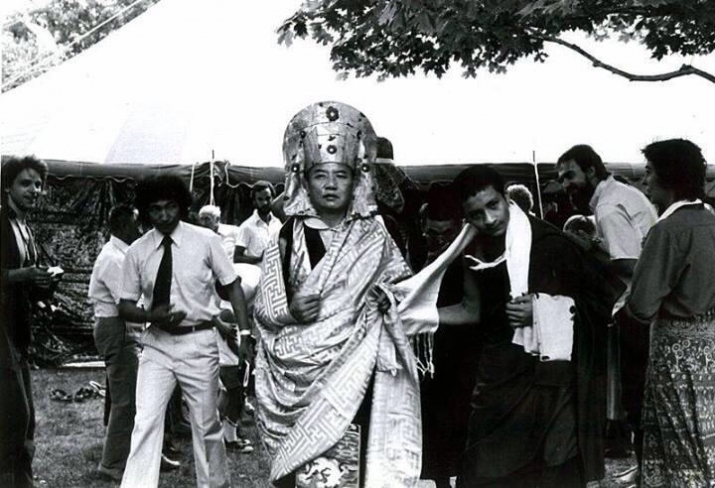 HH the 16th Karmapa before the Black Crown Ceremony, New Hampshire, 1980. From Ngödup Burkhar
HH the 16th Karmapa before the Black Crown Ceremony, New Hampshire, 1980. From Ngödup BurkharNgödup Burkhar has served as translator to His Holiness the 16th Karmapa and other masters in the Karma Kagyu lineage since the early 1970s. Born to a nomadic family near Mount Kailash in Western Tibet in 1953, in 1959 he escaped with his parents and brother to Nepal, where they remained until 1967–68 before moving to Dharamsala in India. There he learned very basic English, and after one year, was sent to an English-medium school in Dehra Dun, graduating at the end of 1972. In early 1973, at a Kalachakra empowerment in Bodh Gaya, he encountered a relative, Lama Drupseng Rinpoche, who suggested that Ngödup go to Rumtek in Sikkim to serve as translator to HH the Karmapa. Shortly thereafter Ngödup received an official letter of invitation from His Holiness, the lama having mentioned the matter on a visit to Rumtek, and Ngödup was on his way. Frances McDonald interviewed Ngödup Burkhar on a recent visit to Hong Kong.
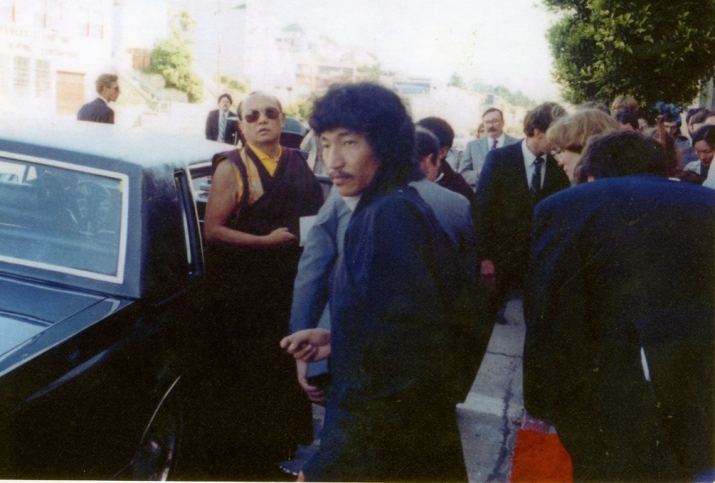 HH the 16th Karmapa with translator Ngödup Burkhar (foreground) arriving at Karma Triyana Dharmachakra, Woodstock, 1980. From Ngödup Burkhar
HH the 16th Karmapa with translator Ngödup Burkhar (foreground) arriving at Karma Triyana Dharmachakra, Woodstock, 1980. From Ngödup BurkharFrances McDonald: How did you feel when Lama Drupseng Rinpoche suggested you go to Rumtek?
Ngödup Burkhar: I wanted to go right away. My family had been connected to the Karma Kagyu lineage for generations. But my English was very basic, and I had very little knowledge of Tibetan—it was a secondary language as I went to an English-medium school. I had no honorific Tibetan—the respectful and colloquial are like two different languages. And forget about Dharma! So I said no, I don’t have anything to offer. Then the letter came from the Karmapa saying that the old lama had mentioned me and that His Holiness had “looked into it,” and that if I came it felt like it would be of some benefit, so it was a bit difficult to refuse. I was excited but also nervous. I would be away from my parents and school friends, and wouldn’t know anyone there.
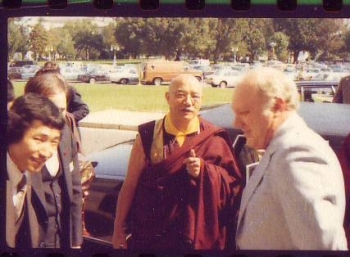 Arriving at the US Senate building and being received by the Sergeant General, 1980. From Ngödup Burkhar
Arriving at the US Senate building and being received by the Sergeant General, 1980. From Ngödup Burkhar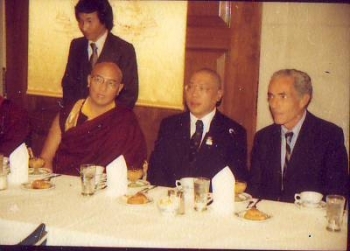 Official visit at the US Senate, with Chögyam Trungpa Rinpoche and Senator Pell of Rhode Island. Each of the senators and congressmen came to greet HH one by one. From Ngödup Burkhar
Official visit at the US Senate, with Chögyam Trungpa Rinpoche and Senator Pell of Rhode Island. Each of the senators and congressmen came to greet HH one by one. From Ngödup BurkharFM: When did you arrive?
NB: In June 1973. I met His Holiness, and it was incredible. But when I got there, he was getting ready to make his first visit to the US at the invitation of Chögyam Trungpa Rinpoche. His Holiness told me to study Dharma with Thrangu Rinpoche while he was away—he was the main abbot of HH the Karmapa’s Seat Monastery in Rumtek. So I tried, but not much happened!
FM: And when His Holiness came back?
NB: When he came back I was translating for him, but there wasn’t much to translate—thank goodness! He actually taught very little in the way of words, he taught through his presence and through his actions. Everybody who came to see him was totally overwhelmed by his presence. They were two different people when they were outside his door and with him, whether they were great teachers, politicians . . . As well as being a translator, I was also a tourist guide for groups who came to the monastery. I did anything that needed English. I learned on the job!
FM: Did you accompany His Holiness to the US later on?
NB: Yes—in August 1977 he sent me to the US to be the main translator for his Seat Monastery in Woodstock, New York, and its affiliate centers in North and South America. I was there on his last tour of North America in 1980.
FM: What was it like being around him all the time?
NB: It wasn’t like any other relationship. I wanted to be close to him—I never got tired of looking at him. I never got tired of the Black Crown Ceremony,* I never got tired of his voice. He had the most amazing voice of all the lamas, Rinpoches, that I have ever come across—the Lion’s Roar. It gave me goose pimples. I was so drawn to him that I should have been able to relax in his presence, but no! There was even one time when I thought my feet were not going to support me. I was in the fire all the time.
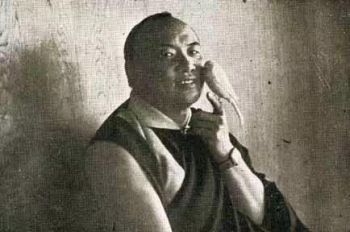 HH the 16th Karmapa with bird, Rumtek, Sikkim, late 1970s. From Ngödup Burkhar
HH the 16th Karmapa with bird, Rumtek, Sikkim, late 1970s. From Ngödup Burkhar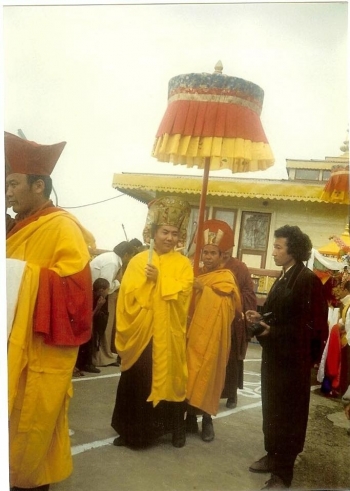 With Jamgön Kongtrul Rinpoche during the funeral procession of Kalu Rinpoche in 1989. From Ngödup Burkhar
With Jamgön Kongtrul Rinpoche during the funeral procession of Kalu Rinpoche in 1989. From Ngödup BurkharFM: Was he ever really wrathful?
NB: Yes, he could be quite wrathful. But there were some moments when I was at ease—two, that I can recall. First, he kept birds. The birds came first—even the chief minister had to wait if His Holiness was attending to the birds! His favorites were finches and canaries. He used to ask me, if I was going anywhere, to get him “pinches”—Tibetans can’t say “f”! He had two aviaries. One was a really big one where the birds could all be free, and the other was on top of the monastery, with many of the birds in cages. One time, he was up there, and I was the only one. He was wearing an apron, and was manicuring and checking them—“I am the best doctor of the birds,” he would tell me proudly. He talked to each one and said the cutest things, like you would say to a baby! But then he asked me if I wanted to help him, and asked me to bring a particular bird cage with “pinches.” So I brought it very respectfully, thinking that the birds were very fortunate—maybe even more fortunate than me! But he said, “Why are you bringing the birds like that? You were supposed to hold them like this!” I had carried the cage by the handle, but I should have held it up, at the same level as my head!
FM: So he told you off?
NB: Yes! His Holiness really loved animals—birds, dogs, snakes. One time we were in Hawaii, and he wanted us to bring birds on the plane. We said, “Look, Your Holiness, it doesn’t work like that!” He wanted them to come with him in the plane. But we couldn’t do it. Another thing he liked to do in his spare time was sewing. One time he was in his room alone, sewing, when I went in. Then he started singing the Song of Gesar, in fact his own composition—he had a beautiful voice.
FM: Are there any recordings of him singing?
NB: One time I heard a little bit of one—he’s singing with the previous Jamgön Kongtrul Rinpoche.
FM: Can you recall any times when you ran into difficulties translating for him?
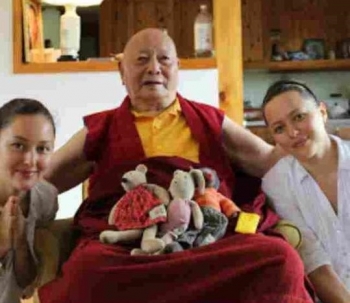 Khenpo Karthar Rinpoche with Ngödup’s daughters, upstate New York, 2014. From Ngödup Burkhar
Khenpo Karthar Rinpoche with Ngödup’s daughters, upstate New York, 2014. From Ngödup BurkharNB: Yes! With all due respect, His Holiness was completely unpredictable. There was one time when he was going to give a talk at Harvard Divinity School in Boston. All the intellectuals would be coming, there was an incredible banner welcoming him . . . I was very excited about it. I had my best suit on, and thought, “This time these people will know what the real thing is!” But I remember that even before the talk I was a little bit surprised. He asked Jamgön Kongtrul, who was like a son to him, to bring the text, which he did, and opened it in front of His Holiness. And His Holiness maybe looked for two minutes, and said there was a mistake. He also said that he was too old to see anything anyway, and asked Rinpoche to close the text. So there we were in Harvard Divinity School, which was packed. Everyone was in suits and ties, and I was very nervous. And then when His Holiness started talking, it didn’t seem to make much sense! Luckily he didn’t talk very much—if he had gone on longer, I would have collapsed. I felt people looking at me with such disgust. It wasn’t like I was new! Finally it ended. Phew! But now there were questions. The questions made sense, but the answers, no sense! I thought about making it up. But one answer was so out of it I couldn’t even make it up. I thought maybe His Holiness didn’t understand the question, so I thought, either I die or I do this, and so I repeated the question to His Holiness. He said, “You say what I said!” I was really thinking the audience was going to kill me, but I did it.
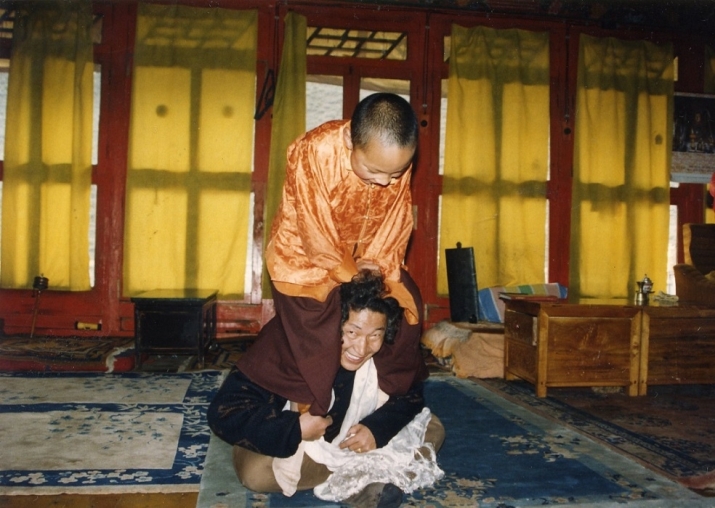 With HH the 17th Karmapa at Tsurphu Monastery near Lhasa, 1993. From Ngödup Burkhar
With HH the 17th Karmapa at Tsurphu Monastery near Lhasa, 1993. From Ngödup BurkharFM: That must have been challenging for you.
NB: Then, later, we were in San Francisco and the program was the Black Crown Ceremony, which sows the seed of liberation on sight. It was California, and the people were very laid back. After the ceremony, he started teaching, and it was so easy, so beautiful, so good, and I was happy to interpret. And I wondered why he hadn’t taught like that at Harvard. But years later, there was some feedback that saved my life, sort of thing. It was in Woodstock, and I was translating for Khenpo Karthar Rinpoche. One comment was something like, “A few years ago, I asked the Karmapa a question. And his answer didn’t make any sense at all. But three years later, it was the best answer!” So I was thinking that it must have been in Boston!
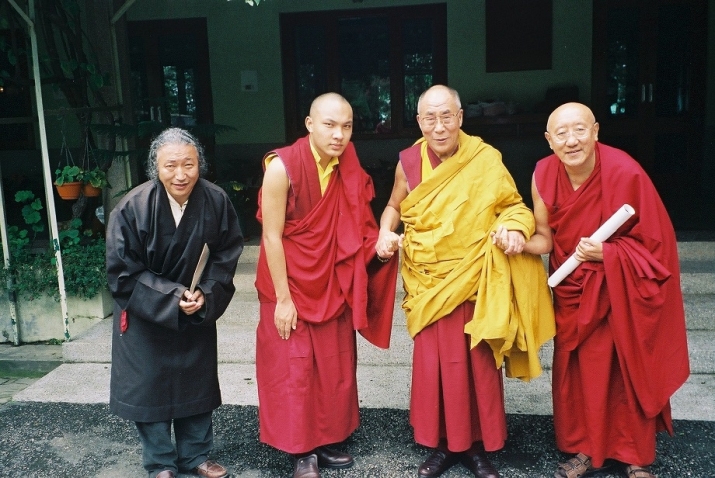 In front of HH the Dalai Lama’s Residence, 2004. Bokar Rinpoche is on the Dalai Lama’s left. From Ngödup Burkhar
In front of HH the Dalai Lama’s Residence, 2004. Bokar Rinpoche is on the Dalai Lama’s left. From Ngödup BurkharFM: You also translated for Khenpo Karthar Rinpoche for many years.
NB: Yes, I interpreted for him for 12 years in the US, starting in 1977—I felt we were pioneers. Nowadays, it’s a different thing! I have a lot of respect for Khenpo Karthar Rinpoche. I’ve also translated many years for Jamgön Kongtrul Rinpoche, Gyaltsab Rinpoche, Kyabje Bokar Rinpoche (chief meditation master of the Kagyu and Shangpa lineages), and His Holiness the 17th Gyalwang Karmapa, Ogyen Trinley Dorje, since 2000 . . . Really, I have translated for the best ones—totally pure, spotless, compassionate. Buildings like stupas are shakable—bodhisattvas aren’t shakable! With Khenpo Karthar Rinpoche, the consistency in his patience was amazing. The consistency in his generosity, the consistency in his devotion. He’s strong—physically and emotionally. But when he talks about the suffering of sentient beings, he’s ready to shed tears every time. Again, when talking about the lineage masters and the Karmapa, he’s just in tears. There is a Tibetan saying, “Those who have the opportunity to lean against a gold mountain, there’s some possibility a little gold will be rubbed off.” Of course, I am not talking about me!
*Black Crown Ceremony
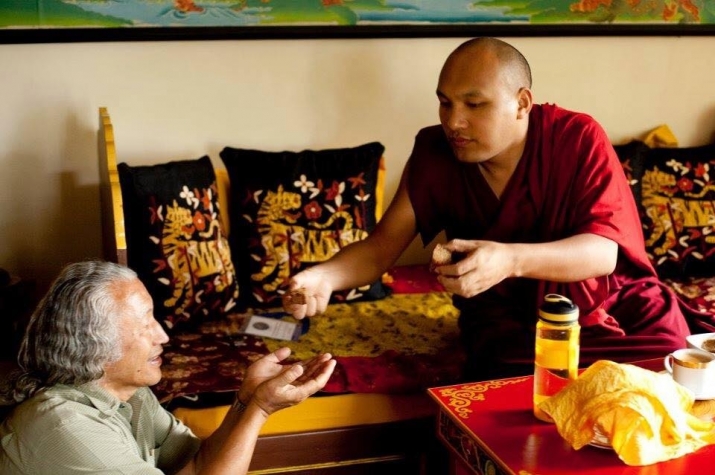 HH the 17th Karmapa giving Ngödup cake during a progam at the Norbulingka, Dharamsala, a few years ago. From Ngödup Burkhar
HH the 17th Karmapa giving Ngödup cake during a progam at the Norbulingka, Dharamsala, a few years ago. From Ngödup Burkhar
























